On-Demand Transplants
In November 2013, an article published in the Chinese state-affiliated Phoenix Weekly highlighted the growth of organ tourism to China within the past decade, and how organs are supplied on-demand and matched quickly with no waiting time. The article also stated that the number of transplants performed in China exceeded that in the U.S.1
In the past decade, with the trend of ‘organ transplant tourism,’ many instances of unbelievably efficient transplant surgeries have appeared in the press. One doctor performed 246 liver transplants in one year. A patient received two kidney transplants within 48 hours…International medical experts have doubts about China’s huge organ sources: as a routine surgery, organ transplantation itself is not difficult; the difficult part is mainly matching and searching for organs. When the international community requires years of waiting to find a matching liver or kidney, why does the ‘searching miracle’ only happen frequently in China?
International medical experts have analyzed the phenomena in China’s organ transplant market. They think China must have an enormous underground human organ bank, or even a living donor organ bank, in which donors have their blood types tested and other related documents prepared ahead of time. When there is “demand”, these living organ donors are sent to hospitals (slaughterhouses)…
… a special characteristic in mainland China is that there is no wait time, and matching organs are found practically on demand …
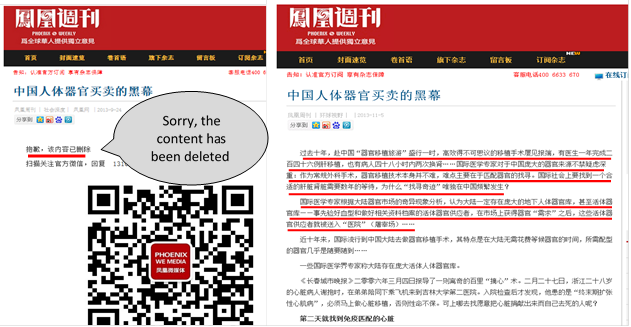
Donors Seeking Recipients
Yunnan Kunming Kidney Disease Hospital is one of the top 100 private hospitals in southwestern China and specializes in kidney and liver transplantation. It has approximately 100 beds2 and has attracted patients from over ten countries and regions.3
When answering a patient’s question online, this hospital referred to itself as “an organ transplant hospital that has donors seeking matched recipients.”
- This is an organ transplant hospital that has donors seeking matched recipients
- Guarantees to every patient to find a healthy kidney in the shortest possible time
- Provides the shortest possible cold and warm ischemia times
- In case of failure, [we will] continue to perform transplants until one is successful, and will not charge for the repeat surgeries.
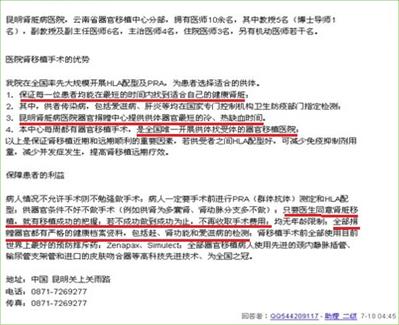
Short Waiting Times
In countries with advanced healthcare capabilities and well-organized organ donation systems, patients usually wait many months or years for a donor organ to become available.4 5 Yet, in China, where organ donation is culturally taboo and there is not yet an effective organ donation system, patients can find matching organs whenever needed, suggesting that there is a large number of readily available organ sources waiting to be matched to patients.
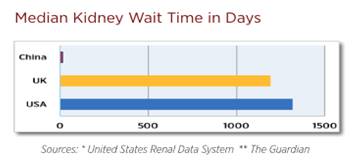
The organ transplantation department of the First Affiliated Hospital of China Medical University, China International Transplantation Network Assistance Center (CITNAC), claimed on its website:
“As for kidney transplantation, it may take one week to find an HLA-matched donor, the maximum time being one month … If an abnormal situation with the donor’s organ is discovered, the center will be responsible for choosing a donor for the patient and commence the operation again within one week.”6
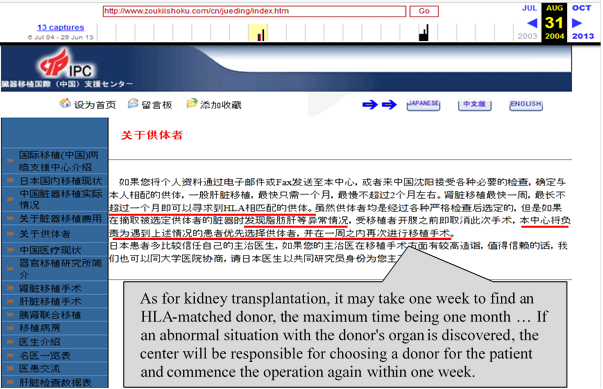
Shanghai Changzheng Hospital’s organ transplant department stated on its application form for liver transplants in 2006 that the average waiting time for liver transplantation was one week7 and that the shortest waiting time was 4 hours.8 Between 2003 and 2006, the hospital performed 120 emergency liver transplants for patients requiring a transplant operation within 72 hours. Outside of China, finding donor organs for such emergency transplants is nearly impossible.
According to the China Liver Transplant Registry’s 2006 Annual Report, among 8,486 liver transplants were performed in 29 facilities in China with 4,331 classified as either emergent or elective. Emergency transplants comprised 1,150 (26.6%) of classified cases.9 Wait times for non-emergency liver transplants were usually quoted in weeks.
Multiple Transplants for the Same Patient
In Mainland China, it is not unusual for doctors to procure multiple organs for use as spares or to perform multiple transplant operations due to rejection, both in quick succession, on the same patient10. These cases have even included third and fourth transplants. On one occasion, eight pairs of kidneys were procured for the same patient.
For example, Tan Jianming, Vice President of the Fuzhou General Hospital of Nanjing Military Command, is reported to have completed more than 4,200 kidney transplants as of 2014.11 Among his patients was a 35-year old male at Shanghai General Hospital in September 2003. In two weeks, Tan was able to acquire 4 sets of kidneys and blood samples, but none of them matched. Later, in March 2004, Tan managed to obtain 4 more sets of kidneys in rapid succession for the same patient, the last of which matched successfully. Thus, 8 pairs of “donor” kidneys were explanted for just one patient.12
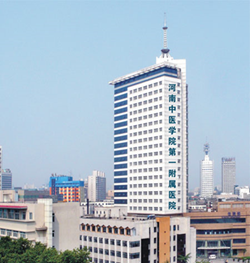
In 2006, a chief surgeon named Wang Guangce published a study analyzing 50 kidney re-transplant cases at the First Affiliated Hospital of Henan University of Traditional Chinese Medicine. Among the 50 cases, 46 were second transplants, 3 were third transplants, and one was a fourth transplant for the same patient. The duration between transplants and re-transplants ranged between 2 hours and 8 years. Five of the cases were orthotopic re-transplants where a second kidney was found and transplanted within 10 days of the original transplant, which indicates that, in 5 such cases, a second kidney was found and transplanted within 10 days. In at least one case, another kidney was found within 2 hours.13
Shen Zhongyang at the Tianjin Oriental Transplant Center performed two separate liver transplants for the movie star Fu Biao. Shen stated that, among this center’s patients, secondary transplants due to improper handling accounted for 10% to 20% of all cases.14
In another example, surgeon Zhu Tongyu at Zhongshan Hospital Affiliated to Fudan University performed a fourth kidney transplant for the same patient.15
Replacing Any Body Part as Needed
The hospitals surveyed performed a wide variety of transplants: kidney, liver, heart, lung, spleen, adrenal glands, pancreas, combined liver-kidney, combined pancreas-kidney, heart-lung, heart-kidney, small intestine, liver-pancreas-duodenum, pancreas-duodenum-kidney, liver-pancreas, liver-small intestine, pancreas-kidney, parathyroid, thyroid-parathyroid-thymus, abdominal organ cluster, all 7 abdominal organs, and eight large full abdominal organs. The list includes 23 kinds of single-organ and multi-organ transplants, including cornea, bone marrow, testicle, bone, skin (including facial), hair, larynx, and many other types of tissue transplants.
Currently, permits from the Ministry of Health are required to conduct six types of solid organ transplants (kidney, liver, heart, lung, pancreas, and small intestine); cell and tissue transplants do not require permits. Yet, the vast majority of institutions have expanded into multiple types of transplants beyond the ones for which they have received permits from the Ministry of Health.
For example, Peking University Third Hospital carries out transplants of heart, lung, cornea, stem cell, bone marrow, vascular grafts, and hair, in addition to the types for which they have approval: liver, kidney, pancreas, and small intestine. This hospital performs eleven types in total.
Sun Yat-sen Hospital of Xiamen University has approval to perform only heart transplants, but also performs nine others including: kidney, liver, pancreas, spleen, lung, heart-lung, small intestine, islet cell, corneal, and bone marrow.
Wuxi People’s Hospital is approved only for lung transplants but also carries out eight other types: kidney, liver, heart, pancreas, cornea, stem cell, bone marrow, and vascular grafts.

References
"Beyond the Dark Veil of China’s Organ Trade Source:Phoenix Weekly Dated:September 24, 2013 The original page has been removed from:"
Original: http://www.51fenghuang.com/news/shehui/2412.html
Archived: https://archive.is/B36qx
中国人体器官买卖的黑幕 《凤凰周刊》2013-9-24
"YunNan Kunming Kidney Disease Hospital – Overview"
Original: http://tag.120ask.com/yiyuan/ynkmszbyy/info.html
Archived: https://archive.is/v7DNL
云南昆明肾脏病医院-概况
"YunNan Kidney Disease Hospital—a branch of the Yunnan Province Organ Transplant Center"
Original: http://www.minghui.org/mh/article_images/2008-9-5-kunming-kidney-02.jpg
云南肾脏病医院-云南省器官移植中心分部
"Organ Transplant waiting times rise fast Guardian July 4, 2011"
Original: http://www.theguardian.com/society/2011/jul/04/organ-transplant-waiting-times-rise
"The Selection of Volunteers (archived web page). CITNAC. August 29, 2007."
Original: http://web.archive.org/web/20040831211012/
Archived: http://www.zoukiishoku.com/cn/jueding/index.htm
《国际移植(中国)网络支援中心》关于供体者
"“Application for Liver Transplantation” of China’s Second Military University Changzheng Hospital The original page has been removed. Refer to its archive:"
Original: http://www.transorgan.com/apply.asp
Archived: http://images.epochweek.com/387/67-01.jpg
《第二军医大学长征医院》“肝移植申请”
"Prognostic Effects and Treatments of Severe Hepatitis Cases Journal of Clinical Surgery Volume 14, Issue 6, June 2006 Fu Zhiren and Ma Jun"
Original: http://www.zhuichaguoji.org/sites/default/files/files/report/2015/06/48090_image044.png
重型肝炎急诊肝移植的预后影响因素及处理 《临床外科杂志》2006年6月第14卷6期 傅志仁, 马钧
"China Liver Transplant Registry’s 2006 Annual Report China Liver Transplant Registry"
Original: http://www.slideserve.com/lerato/2006
Archived: http://web.archive.org/web/20160216043257/http://www.slideserve.com/lerato/2006
《中国肝移植注册2006年度报告》 来源:中国肝移植注册网
"Bloody Harvest: Organ Harvesting of Falun Gong Practitioners in China (Revised Edition) Appendix 5. The Recipient Experience January 1, 2007 David Matas, David Kilgour"
Original: http://organharvestinvestigation.net/report0701/report20070131.htm#_Toc158023098
《血淋淋的器官摘取—关于指控中共摘取法轮功学员器官的调查报告修订版》
"Awarded Physician of Chinese Physician Prize – Tan Jianming Source: Chinese Physician Association Website 2014"
Original: http://www.doctorpda.cn/prize/2014/detail/?id=76
Archived: http://web.archive.org/web/20170112182634/http://www.doctorpda.cn/prize/2014/detail/?id=76
中国医师奖获奖医师-谭建明 来源:中国医师协会官网 2014
"Bloody Harvest: Organ Harvesting of Falun Gong Practitioners in China (Revised Edition) Appendix 5. The Recipient Experience January 1, 2007 David Matas, David Kilgour"
Original: http://organharvestinvestigation.net/report0701/report20070131.htm#_Toc158023098
《血淋淋的器官摘取—关于指控中共摘取法轮功学员器官的调查报告修订版》
"In China, 98% of Organ Transplant Sources Controlled by Parties Other Than Ministry of Health Life Weekly, Sina.com April 7th , 2006 Guo Na"
Original: http://www.transplantation.org.cn/zyieneilifa/2006-04/467.htm
Archived: https://archive.is/Ixf9t
中国98%器官移植源控制在非卫生部系统 《三联生活周刊》新浪网 2006-4-6
"A successful fourth renal transplantation for a uremic patient with a single Kidney The personal website of Dr. Zhu Tongyu doctor"
Original: http://www.haodf.com/zhuanjiaguandian/tyzhu_2425963681.htm
Archived: https://archive.is/VxyU0
“独肾”尿毒症患者第四次肾移植手术成功 朱同玉大夫的个人网站

